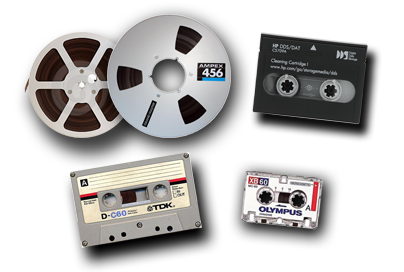Audio tape to mp3 or CD-ROM
Main audio formats
Audio cassette tape
In 1962, Philips invented the Compact Cassette medium for audio storage, introducing it in Europe on 30 August 1963 and in the United States in November 1964, with the trademark name Compact Cassette. Although there were other magnetic tape cartridge systems, Philips' Compact Cassette became dominant as a result of Philips' decision in the face of pressure from Sony to license the format free of charge.
Reel to reel magnetic tape
The reel-to-reel format was used in the earliest tape recorders, including the pioneering German-British Blattnerphone machines of the late 1920s which used steel tape, Originally, this format had no name, since all forms of magnetic tape recorders used it. The name arose only with the need to distinguish it from the several kinds of tape cartridges or cassettes such as the endless loop cartridge developed for radio station commercials and spot announcements in 1954, the full size cassette, developed by RCA in 1958 for home use, as well as the compact cassette developed by Philips in 1962, originally for dictation.
Digital Audio Tape (DAT)
Digital Audio Tape (DAT or R-DAT) is a signal recording and playback medium developed by Sony and introduced in 1987.In appearance it is similar to a Compact Cassette, using 4 mm magnetic tape enclosed in a protective shell, but is roughly half the size at 73 mm × 54 mm × 10.5 mm. As the name suggests, the recording is digital rather than analog.
Microcassette
Small Micro Cassettes were commonly used in hand held voice recording devices and telephone answering machines. Tape duration would depend upon the initial recoding speed but generally the tapes had a capacity of 60 minutes. Also used for interview work out in the field we can transfer valuable recorded information to all of the common digital audio formats.
Audio can be transferred from a variety of analogue sources, such as, Audio Cassette, Reel-to-Reel magnetic tape, DAT (Digital Audio Tape) Micro Cassette and Vinyl Records.
The converted audio can be supplied on CD-ROM or MP3 for playback on all modern digital devices.
Audio can be transferred to standard CD-ROM for playback on small domestic players, car CD systems and most computers.
CD-ROM format will hold only 80 minutes of audio so longer recordings would be spanned across multiple CD's. Alternatively MP3 is a high quality heavily compressed format that can also be played on most modern CD players, computers and car audio systems.
Mp3 is the preferred format for audio as it can be played back on just about all electronic devices, such as computers, mobile phones, iPad and in the car sterio system.
Magnetic tape became very popular in the 1950's~1960's for music and voice recording.
Audio letters were a popular way to communicate with distant relatives using small portable tape recorders to record conversations at family gatherings.
Acetate tape over a period of time will curl and shrink causing degradation in playback quality. Polyester tape also has its problems, especially tape formulations from the USA around 1975 to 1985 which left a sticky substance on the rollers and heads causing a drop in sound fidelity.
Age is perhaps the biggest drawback for magnetic tape, so if you have audio material archived on tape then it's important to act fast before the tape becomes unplayable.
We have the capacity to transfer the following audio formats.
Copyright law prevents us from copying material to another format unless you are the legal owner of such material. Our audio transfer service is therefore restricted to audio recordings other than commercially available music such as audio letters, recorded family events and other recordings that you have recorded and have full legal ownership.
The law does states that you may make your own digital backup copies, however it cannot be offered by us as a service.
